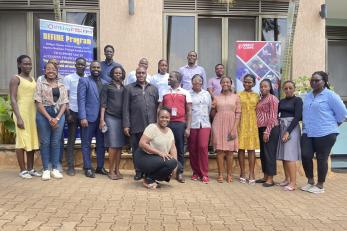Through the Gender Lens
Investigating the Impact of Gender on the Financial Lives of Displaced Communities

This webinar recording presents highlights from the second edition of Mercy Corps’ State of the Refugee Finance Sector report series. It articulates the business case for gender to market actors, highlights critical gender issues that impact finance delivery in displacement settings, and shares gender-related lessons from Mercy Corps’ AFD-funded ReFine program.
Financial services today do not work for marginalized communities as they should; this situation is even graver for forcibly and internally displaced women who face a host of barriers, stereotypes and limitations when accessing, using and benefiting from financial services compared to their male counterparts.
Refugee women, in particular, continue to face legal and identity documentation issues, economic barriers such as low and unstable incomes, mobility restrictions impeding the accessibility of financial access touchpoints, a persistent digital gender divide, and a confluence of social and cultural barriers that affect resource ownership and use.
As the global humanitarian funding deceleration forces attention to refugee finance and market systems development, the needs of displaced women must be prioritised by development and market actors alike to ensure that no one is left behind and that balanced growth is achieved for all. This report develops the ideas introduced in the first State of the Refugee Finance Sector report and advocates for a financial sector that adequately responds to the needs of refugee and host women, not just in rhetoric but also in reality.
While comprehensive global statistics specific to forcibly displaced persons (FDPs) are largely unavailable, broader studies indicate that the gender gap in financial inclusion is likely wider among FDPs than the general population. In Sub-Saharan Africa (SSA), a region with the highest gender gap in financial services access in the world, (13% compared to the global average of 4% - Global Findex 2021) those living in forcible displacement are likely to face even greater disparities in access and usage of formal financial services and economic wellbeing. Despite the progress made by humanitarian, development and financial institutions in rolling out notable financial products and projects to address the financial exclusion gender gap in recent times, real and sustainable gains can be achieved if the financial sector leads on gender-inclusive finance from a commercial standpoint. That can happen when financial service providers (FSPs) prioritise women’s needs from the product design stage and re-design the many “gender-neutral” financial products on the market with women’s needs in mind. The varied needs of women, often different from those of men, are driven by the obstacles they face in their attempt to access and use formal financial services.
The report delves into the spectrum of issues affecting:
- Women’s economic advancement and opportunity (driven by women’s difficulty in accessing decent employment, their low incomes and low return on labour driven by society’s expectations of women around domestic work and child care).
- Access to opportunity, skills training or education (hampered by women’s mobility restrictions, cultural norms, and the digital gender divide).
- Access to assets and support services (fueled by negative societal beliefs about women’s ownership and control of resources).
- Women’s agency and decision-making power (typified by cultural and religious beliefs in what women should and can exercise control over, exemplified in instances such as elite capture within savings groups and other leadership structures).
Collectively, these barriers are crippling factors to the self-reliance and financial inclusion of refugee women; however, they also serve as clues to the underlying needs of women for FSPs who wish to design for and retrofit their existing products and services to meet those needs.
Successful strategies adopted by refugee-serving FSPs globally as well as in Uganda, have focused on the following:
- Proactively working with regulators and legislators to adapt policies and products to women’s needs.
- Collecting gender-disaggregated data on product access and use - and using this data to inform collateral requirements, loan repayment schedules, and product packaging.
- Complementing business and digital curricula with mentoring and handholding.
- Being intentional about working with refugee-led organisations (RLOs) throughout the loan origination process till recovery.
Increasingly, more FSPs are beginning to implement these strategies either partially with funder support or independently, which speaks to a growing recognition of a business case for women in marginalised settings. They are also beginning to experience the payoffs: they are seeing more loyal clients in women than men, recording better loan repayment rates and higher savings-to-income ratios, becoming more compliant with emerging regulatory trends and enjoying more brand equity in their markets.